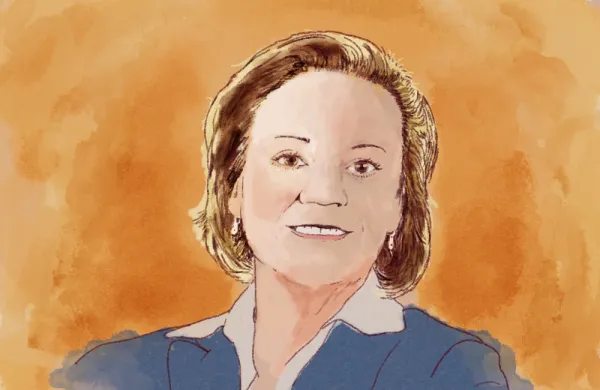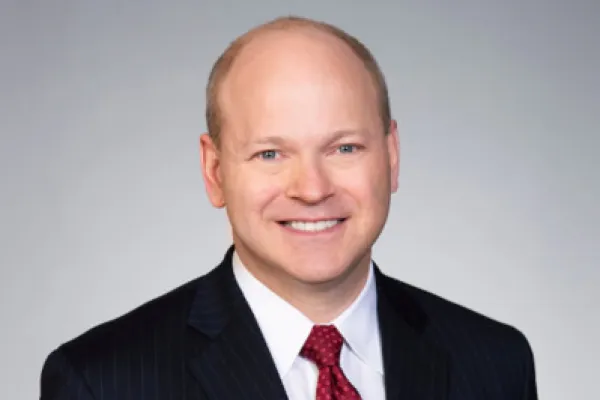At his farm in Huelva, a hilly province in southwestern Spain, Gerhard Bruckermann will soon harvest his first crops of neem and moringa, exotic plants native to India and known to cognoscenti for their medicinal qualities. "These are underutilized plants, and I would like to increase their acceptance," says the chief of DePfa Bank.
Bruckermann, 55, is wielding a green thumb in the financial world as well these days. He's nurturing a variation of a German financial product, the Pfandbrief, in Ireland and trying to sell it to a broad cross-section of European buyers. He hopes that it will also take root on U.S. and Asian soil.
Bruckermann runs a bank that is itself a kind of transplant. DePfa was spun off last year from Deutsche Pfandbriefbank, Germany's leading issuer of Pfandbriefe, high-quality bonds secured by a pool of assets, usually mortgages or loans to public sector borrowers. The 81-year-old Deutsche Pfandbriefbank, a onetime government lender, split itself into Bruckermann's DePfa Bank, a public finance specialist with E150 billion ($178.6 billion) in assets, and Aareal Bank, a Wiesbaden-based mortgage and property group with E37.3 billion in assets.
In a switch many German bank CEOs would have envied, DePfa moved its headquarters and about 120 of its 350-member staff to tax-friendly Dublin, where new laws allow the issuance of a Pfandbrief clone, the asset-covered security. The bank's shares are still listed in Frankfurt, and it maintains a sizable business in Germany, but thanks to its new Dublin headquarters, DePfa can distance itself from the many problems stifling German banks.
Bruckermann's goal is to transform DePfa from a solid domestic player into a global leader in public sector financing. At present the cost-conscious bank has three main business lines: It lends money to public entities ranging from national governments to municipalities and refinances the loans by issuing Pfandbriefe or asset-covered securities; it provides investment banking advice to governments on their financing alternatives; and it finances infrastructure projects overseen by governments. Double-A-rated DePfa maintains a very conservative balance sheet on which more than 75 percent of its assets carry a zero risk weighting under international banking regulations. Major clients include the Treasuries of Germany and Italy.
Bruckermann aims to diversify DePfa's German lending and borrowing base throughout Europe and strengthen its toehold overseas. Says he, "We're trying to take the powerful business model we have here on the road." Aside from selling its euro-based Pfandbriefe and asset-covered securities to U.S. and Japanese buyers, DePfa is eyeing other niches in those countries: offering liquidity and credit enhancement to public borrowers and creating bigger dollar- and yen-denominated Pfandbrief markets.
For the moment, Bruckermann is expanding his bank under near-ideal conditions. With public entities from Madrid to Tokyo facing budgetary pressures, the services of a well-heeled financier are in demand. Declining rates have spurred additional desire for financing (and refinancing) and given the interest-sensitive bank a healthy spread. What's more, with the dollar declining, DePfa's euro-based products are enjoying newfound interest.
In February the bank made a bold move: It issued the first asset-covered securities under recently passed Irish legislation designed to lure some of the E400 billion market in Pfandbriefe and related bonds to Dublin. The triple-A-rated issue, secured by a broad portfolio of loans to public borrowers in Austria, Belgium, Finland, France, Germany, Greece, Italy, the Netherlands and Spain, drew strong international interest. Demand was sufficient to raise the amount offered to E5 billion from E4 billion. "After this it doesn't matter if the bond is issued in Dublin or Frankfurt," Bruckermann says. Indeed, in late May DePfa returned to market with a second Irish asset-covered security offering, for E3.5 billion. As a result, the bank has already exceeded its E8 billion forecast for asset-covered security issuance this year.
DePfa's numbers tell the story. In mid-May the bank posted first-quarter net profits of E83 million, a 43 percent year-on-year gain; revenues rose to E144 million, a 31 percent jump. Bruckermann told analysts that the bank might exceed its 2003 profit forecast of E250 million -- E300 million, he said, isn't out of reach. Since late February shares of DePfa, whose portfolio lacks exposure to Germany's swooning stock market, have doubled, to about E58.
Bruckermann certainly runs an efficient operation. DePfa's cost-income ratio is about 30 percent, roughly 5 percentage points lower than those of European rivals like Germany's Eurohypo and Paris-based Dexia Group, a financial services conglomerate composed of Belgian, French and Luxembourger institutions. That ratio is less than half that of the typical German bank.
"Most banks are concentrating on managing down costs because their ability to significantly grow revenue is constrained," says Leslie Mapondera, a bank analyst at Credit Suisse First Boston. "DePfa's cost management compares favorably with other banks in the sector, and from a revenue perspective, public sector financing is a growing area. DePfa's issuance of public sector debt (which totals E55 billion) has been growing rapidly, so it's well placed from a revenue standpoint, too."
DePfa must overcome some doubts. Interest rates won't stay low forever, and that fact raises questions about the bank's ability to thrive in less hospitable circumstances. And even if favorable operating conditions persist, DePfa faces serious competition. Smaller, local banks are vying for Pfandbrief-type business in Europe, and both Dexia and Eurohypo compete vigorously with DePfa all over the world. Both have already moved into the U.S. Giant banks like J.P. Morgan Chase & Co. and WestLB dominate public financerelated lending in the U.S., where a handful of financial guarantors are well entrenched. Japan, though desperate for liquidity, is still a notoriously difficult marketplace for foreign banks.
Bruckermann, who joined Deutsche Pfandbriefbank to run its public finance business in 1991, just after it was privatized, views the initial Irish ACS sales as the handsome payoff for several years of work to establish a solid European base for DePfa's international ambitions. He first presented the idea of a spin-off to the board in the summer of 2000. It wasn't an easy sell. "At the time, everybody thought strategically about mergers and economies of scale, and here was a small, specialist bank splitting even more," he recalls. To Bruckermann, however, smaller means faster. "We have the speed of decision making of a smaller, private bank combined with the muscle of a larger institution. If you need 5 to 10 billion euros' financing next week without spreading it around the market, we can do it." In October 2001 the board and DePfa's major investors -- German and Swiss banks and insurers -- approved the spin-off, which happened in July 2002.
In its bid to expand beyond Germany, DePfa found a willing partner in the Irish government, which had been keen to lure a portion of the Pfandbrief market to Dublin. In December 2001 the government passed comprehensive legislation giving investors in asset-covered securities first claim on assets in a bankruptcy and setting stringent quality guidelines for issuing banks. The law also grants issuers like DePfa much greater flexibility in selling asset-covered securities. In Germany, for instance, 90 percent of a Pfandbrief's underlying loans must come from Austrian, French, German or Luxembourger borrowers; Ireland allows the underlying loans to originate anywhere in the European Economic Area, and 15 percent may come from non-European Group of Seven countries. Expansion of DePfa's lending programs into the U.S. or Japan or even further into emerging Europe would have been difficult, if not impossible, under the restrictive German rules.
Bruckermann acknowledges another advantage of his new home: He's not running a German bank. Plagued by regulation, a weak economy and chronically low margins, German institutions have lost favor with investors everywhere, and their woes have begun to infect the Pfandbrief market. In early April Moody's Investors Service downgraded a mortgage-backed Pfandbrief issued by HVB Real Estate Bank because of concerns about its parent, HVB Group, the country's second-largest private sector bank.
The gregarious Bruckermann, who was born in Solingen and lives in London with his American wife and three children, is eager to emphasize that more than his bank's address is different: "Our corporate governance has changed from the German model to the Anglo-American model," he says. Nonexecutive members now hold a majority on the DePfa board, and the company adheres to the U.S.'s generally accepted accounting principles.
DePfa has benefited from a number of positive developments beyond Germany's borders -- not least, legal changes in many countries that, like Ireland, have given investors greater powers to seize assets if problems occur. France, Luxembourg and Spain have already created rapidly growing marketplaces for equivalent vehicles known as obligations foncières, lettres de gage and cédulas hipotecarias, respectively.
"With the establishment of other liquid covered bond product has come diversification away from German names with similar credit risks," says Martin Keutner, the executive director responsible for German debt capital markets at UBS Warburg. "Within the asset class there is a much broader differentiation than this market was used to a few years ago."
The diversification of credit ratings also appeals to investors. Pfandbriefe historically were "a pure triple-A asset class," notes Keutner. That changed when issues outside Germany, particularly in Spain, reached the market with lower ratings. Then came the German banks' credit crisis, which created spread differentials. Ironically, some investors who bought non- German deals because they were weaker credits with higher yields are now looking outside Germany to find stronger credits.
Sales of jumbo Pfandbriefe -- larger issues (including asset-covered securities) of at least E500 million, first offered in 1995 to attract big institutional investors -- reflect the market's diversification. Jumbo issuance climbed to E48.4 billion this year through April, compared with E71.3 billion for all of 2002, according to Bondware, which tracks deal volume. (Bondware is a unit of Euromoney Institutional Investor.) Significantly, half of the 2003 issuance has taken place outside Germany, versus one third last year.
WILL DEPFA'S APPROACH ATTRACT U.S. and Japanese investors? Analysts believe that the expansion can work if the bank doesn't forsake its cost-efficient style. International growth "makes sense where market entry costs are relatively low and the diversity of the bank's loan and business portfolio is improved," says CSFB's Mapondera.
Although DePfa has kept an office in New York since 1998, only last month did it receive a banking agency license to ramp up its operations there. The goal, explains Herbert Jacobs, who heads DePfa USA, is to offer public financing via loans and standby repurchase agreements for bond insurers.
Although J.P. Morgan Chase and WestLB control the bulk of the U.S. market for such financing, Jacobs sees an opening. The ranks of bank lenders have thinned. The once-mighty Japanese have departed, U.S. institutions have pulled back or merged, and some European lenders no longer have the credit standing to lend aggressively. There are fewer lenders today than in the 1980s, says Jacobs.
Meanwhile, there has been a surge in demand for credit. California, for instance, is expected to run a budget deficit of about $35 billion over the next 18 months. Notes Jacobs, "No one public finance bank can commit sufficient enhancement facilities on its own to fully meet California's funding needs."
DePfa is also committed to creating a U.S. market for dollar-denominated Pfandbrief issues so that it can diversify its own funding sources and expand name recognition for the security worldwide. Dexia and Eurohypo have done dollar-based Pfandbriefe in the past. Last year DePfa joined them by raising $2 billion.
DePfa believes that it can give U.S. investors an alternative to the prevailing mortgage- and loan-backed securities from U.S. agencies like the Federal Home Loan Mortgage Corp., the Federal National Mortgage Association and the Student Loan Marketing Association. "In the U.S. you have this huge agency market -- all these Freddies, Fannies and Sallies. I've spoken to investors, and they are all looking for diversity," says Wally Hoefer-Neder, DePfa's head of global capital markets. "We are offering an alternative."
Bruckermann concedes that DePfa won't succeed in the U.S. overnight. Still, he plans to take a similar tack in Japan, where DePfa has had a rep office since 1995. The bank wants to build a bigger domestic market in the yen-denominated issues that it sells to the central bank as well as to Japanese funds, banks and insurers. (It has already sold the equivalent of E7.5 billion in yen transactions.)
Of course, Japan, where the national debt equals roughly 140 percent of GDP, offers fertile ground for any patient, deep-pocketed lender. Here DePfa will focus on lending to and advising government agencies, prefectures and metropolitan authorities. "It's a good point in the pricing cycle, especially if you have resources," says one banker. "If you don't see the benefits" of expanding in Japan, says Bruckermann, "you shouldn't be in this business."
Fair enough, but DePfa still must prove that it can manage a global public finance business in a less favorable economic climate. Even in last year's bull market for bonds, the bank had E21 million in hedging-related losses. And as recently as five years ago, the highly cyclical U.S. public finance business was in tatters, with issuance off nearly 50 percent. Running a bank in that kind of climate will surely test Bruckermann's green thumb.





